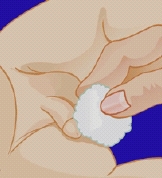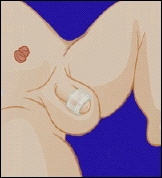Care After Circumcision
Care After Circumcision
Circumcision is a simple procedure most often done in the nursery before a baby boy goes home from the hospital, if the family has chosen to have it done. Circumcision can be done in a number of ways. Your healthcare provider will explain the procedure and tell you what to expect. To care for your son after circumcision, follow the tips below.
What to expect
|
Keep the penis clean
|
For the Gomco or Mogan clamp
|
For the Plastibell device
|
When to call your healthcare provider
The penis is very red or swells a lot.
Your child develops a fever (see Fever and children, below).
Your child has had a seizure.
Your child is acting very ill, listless, or fussy.
The discharge becomes heavy, is a greenish color, or lasts more than a week.
Bleeding cannot be stopped by applying gentle pressure.
Fever and children
Always use a digital thermometer to check your child’s temperature. Never use a mercury thermometer.
For infants and toddlers, be sure to use a rectal thermometer correctly. A rectal thermometer may accidentally poke a hole in (perforate) the rectum. It may also pass on germs from the stool. Always follow the product maker’s directions for proper use. If you don’t feel comfortable taking a rectal temperature, use another method. When you talk to your child’s healthcare provider, tell him or her which method you used to take your child’s temperature.
Here are guidelines for fever temperature. Ear temperatures aren’t accurate before 6 months of age. Don’t take an oral temperature until your child is at least 4 years old.
Infant under 3 months old:
Ask your child’s healthcare provider how you should take the temperature.
Rectal or forehead (temporal artery) temperature of 100.4°F (38°C) or higher, or as directed by the provider
Armpit temperature of 99°F (37.2°C) or higher, or as directed by the provider
Child age 3 to 36 months:
Rectal, forehead (temporal artery), or ear temperature of 102°F (38.9°C) or higher, or as directed by the provider
Armpit temperature of 101°F (38.3°C) or higher, or as directed by the provider
Child of any age:
Repeated temperature of 104°F (40°C) or higher, or as directed by the provider
Fever that lasts more than 24 hours in a child under 2 years old. Or a fever that lasts for 3 days in a child 2 years or older.
Updated:
April 19, 2018
Sources:
The Gale Encyclopedia of Nursing and Allied Health. B. Narins. 2013;3:770-71.
Reviewed By:
Adler, Liora C., MD,Freeborn, Donna, PhD, CNM, FNP,Turley, Ray, BSN, MSN

